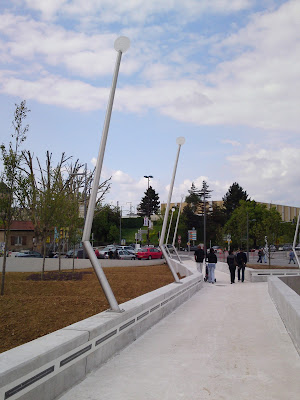2010-05-25
Snaking path
Industrial Burbach in the foreground, Gersweiler, the other side of the Saar, in the background. The path mainly leads to the colourful lock.
2010-05-17
Centre Pompidou à Metz
Opened last week by President Sarkozy, currently host to some of the best works of art of the twentieth century.
2010-05-13
Evening panorama
As indicated in the previous photo, I was surprised to step out of miles of forest to see this vista. In fact, looking up the location on Google maps, I am even more surprised. At the time of the Google satellite pictures, the valley was still being mined. The other surprise is that I was unknowingly standing on the frontier. The viewing platform is German, but all the valley is French.
2010-05-12
Forest with a view
Hours in the forest, nothing but trees, trees, path and more trees. And then a viewing platform. What can there be to see?
2010-05-09
Caged water
With the decision of June 8, 2008, the Ministry of Justice, Work, Health and Social Affairs has declared the water in bore number 6 to be official mineral water
2010-05-05
The Parliament of Saarland
Saarland is a tiny state (ca 1,000,000 inhabitants) and Saarbrücken is its tiny capital (ca 180,000 inhabitants).
2010-05-04
Stony bee
The main entrance to the Saarland Constitutional Court (Verfassungsgerichtshofs des Saarlandes)
2010-05-01
Huguenot Church
Built in 1786, after one of several waves of refugees of Huguenot Protestants escaping persecution in Catholic France. The French family names remain in the village, but the French language and the Huguenot traditions have died out.
Subscribe to:
Comments (Atom)






























